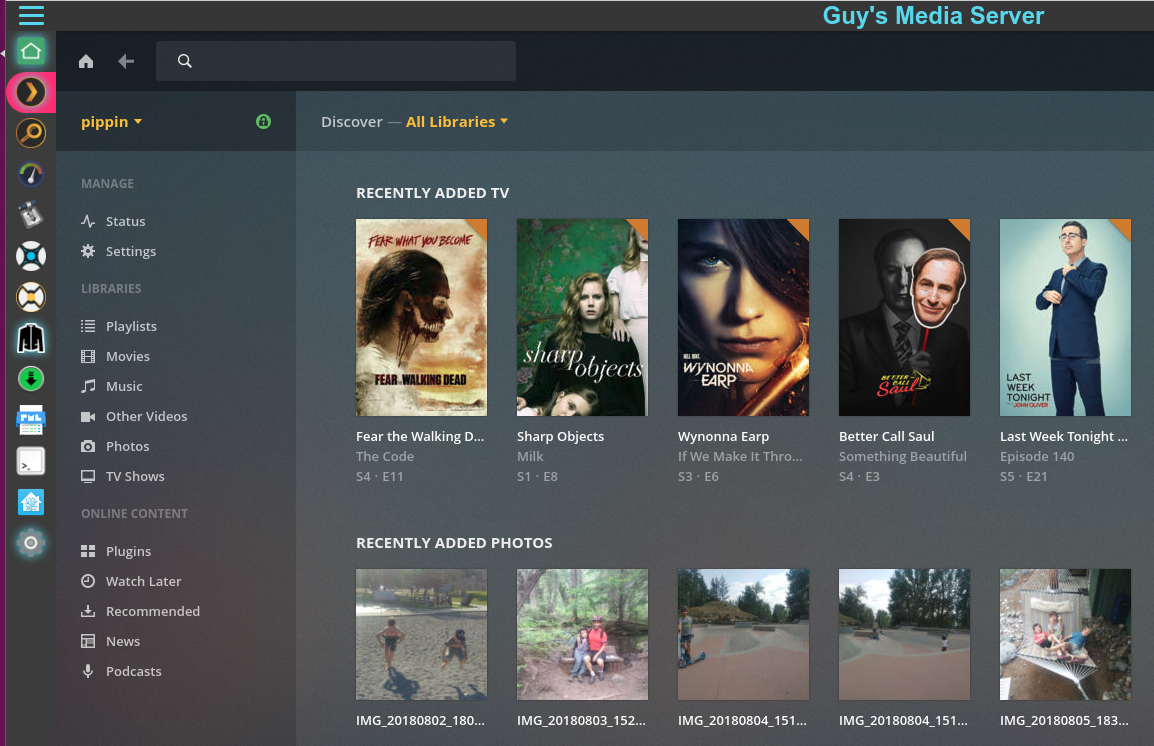Following up on my earlier post about hosting my own private media server this will cover the details of proxying web access from Nginx through to backend services. Interfaces are managed via Organizr.

This uses the cookie-based authorization available from Organizr.
Nginx organizr.conf
send_timeout 5m;
proxy_read_timeout 240;
proxy_send_timeout 240;
proxy_connect_timeout 240;
client_header_timeout 240;
client_body_timeout 240;
location / {
root /opt/organizr/html;
index index.php index.html index.htm index.nginx-debian.html;
location /auth-admin { rewrite ^ /auth.php?admin&ban=someone,thisperson; }
location /auth-user { rewrite ^ /auth.php?user&ban=someone,thisperson; }
error_page 400 401 403 404 405 408 500 502 503 504 /error.php?error=$status;
location / {try_files $uri $uri/ =404;}
location ^~ /PimpMyLog/ {
auth_request /auth-admin;
include config/phpblock.conf;
}
include config/phpblock.conf; #PHP Block
}
location /transmission {
if ($cookie_cookiePassword != "TestPassword") { return 403; }
add_header X-Frame-Options "SAMEORIGIN";
proxy_pass http://127.0.0.1:9091;
proxy_set_header Host $host;
proxy_set_header X-Real-IP $remote_addr;
proxy_set_header X-Forwarded-For $proxy_add_x_forwarded_for;
}
location /nzbget {
if ($cookie_cookiePassword != "TestPassword") { return 403; }
add_header X-Frame-Options "SAMEORIGIN";
proxy_pass http://127.0.0.1:6789;
proxy_set_header Host $host;
proxy_set_header X-Real-IP $remote_addr;
proxy_set_header X-Forwarded-For $proxy_add_x_forwarded_for;
}
location /sonarr {
if ($cookie_cookiePassword != "TestPassword") { return 403; }
add_header X-Frame-Options "SAMEORIGIN";
proxy_pass http://127.0.0.1:8989;
proxy_set_header Host $host;
proxy_set_header X-Real-IP $remote_addr;
proxy_set_header X-Forwarded-For $proxy_add_x_forwarded_for;
}
location /radarr {
if ($cookie_cookiePassword != "TestPassword") { return 403; }
add_header X-Frame-Options "SAMEORIGIN";
proxy_pass http://127.0.0.1:7878;
proxy_set_header Host $host;
proxy_set_header X-Real-IP $remote_addr;
proxy_set_header X-Forwarded-For $proxy_add_x_forwarded_for;
}
location /jackett {
if ($cookie_cookiePassword != "TestPassword") { return 403; }
add_header X-Frame-Options "SAMEORIGIN";
proxy_pass http://127.0.0.1:9117;
proxy_set_header Host $host;
proxy_set_header X-Real-IP $remote_addr;
proxy_set_header X-Forwarded-For $proxy_add_x_forwarded_for;
proxy_set_header X-Forwarded-Proto $scheme;
proxy_set_header X-Forwarded-Host $http_host;
proxy_redirect off;
}
location /plex/ {
if ($cookie_cookiePassword != "TestPassword") { return 403; }
add_header X-Frame-Options "SAMEORIGIN";
proxy_pass http://192.168.1.114:32400/;
client_max_body_size 10m;
client_body_buffer_size 128k;
proxy_bind $server_addr;
proxy_buffers 32 4k;
#Timeout if the real server is dead
proxy_next_upstream error timeout invalid_header http_500 http_502 http_503;
# Advanced Proxy Config
send_timeout 5m;
proxy_read_timeout 240;
proxy_send_timeout 240;
proxy_connect_timeout 240;
proxy_hide_header X-Frame-Options;
# Basic Proxy Config
proxy_set_header Host $host:$server_port;
proxy_set_header X-Real-IP $remote_addr;
proxy_set_header X-Forwarded-For $proxy_add_x_forwarded_for;
proxy_set_header X-Forwarded-Proto https;
proxy_redirect http:// $scheme://;
proxy_http_version 1.1;
proxy_set_header Connection "";
proxy_no_cache $cookie_session;
proxy_set_header Upgrade $http_upgrade;
proxy_set_header Connection "upgrade";
}
if ($http_referer ~* /plex/) {
rewrite ^/web/(.*) /plex/web/$1? redirect;
}
location /plexpy {
if ($cookie_cookiePassword != "TestPassword") { return 403; }
add_header X-Frame-Options "SAMEORIGIN";
proxy_pass http://192.168.1.114:8181;
proxy_set_header Host $http_host;
proxy_set_header X-Forwarded-For $proxy_add_x_forwarded_for;
proxy_set_header X-Forwarded-Host $server_name;
proxy_set_header X-Forwarded-Proto $scheme;
proxy_set_header X-Real-IP $remote_addr;
}
location /ombi/ {
if ($cookie_cookiePassword != "TestPassword") { return 403; }
add_header X-Frame-Options "SAMEORIGIN";
proxy_pass http://127.0.0.1:5000;
proxy_http_version 1.1;
proxy_set_header Upgrade $http_upgrade;
proxy_set_header Connection keep-alive;
proxy_set_header Host $host;
proxy_cache_bypass $http_upgrade;
}
if ($http_referer ~* /ombi/) {
rewrite ^/dist/([0-9\d*]).js /ombi/dist/$1.js;
rewrite ^/loading.css /ombi/loading.css;
}
Naturally, I replaced TestPassword above with a strong password.
Conclusion
Overall, I’ve found Nginx and Organizr to work very well together. I particularly like the delegation of authentication to Plex itself, which maps to friends and family I’ve shared access with.
More in this series…
- Private Media Server - overview of my server.
- Nginx and Organizr v2 - updated proxying for Organizr v2.